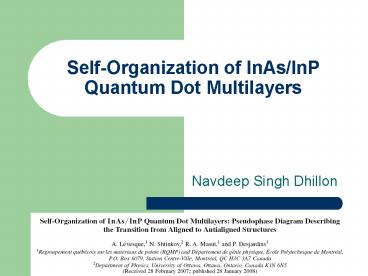Self-Organization of InAs/InP Quantum Dot Multilayers - PowerPoint PPT Presentation
1 / 12
Title:
Self-Organization of InAs/InP Quantum Dot Multilayers
Description:
Self-Organization of InAs/InP Quantum Dot Multilayers Navdeep Singh Dhillon Overview Regimes of 3-D self-organization in quantum dot layers described using ... – PowerPoint PPT presentation
Number of Views:61
Avg rating:3.0/5.0
Title: Self-Organization of InAs/InP Quantum Dot Multilayers
1
Self-Organization of InAs/InP Quantum Dot
Multilayers
- Navdeep Singh Dhillon
2
Overview
- Regimes of 3-D self-organization in quantum dot
layers described using - Experimental observations for InAs/InP(001)
system - Atomistic Strain calculations
- Pseudophase diagram developed to explain
transition from vertically aligned to
anti-aligned layers
3
Motivation
- Periodicity and size uniformity of quantum dots
grown in Stranski-Krastanov mode important for
device applications - Detailed understanding of physical origin of
phenomena prerequisite for obtaining the required
3-D arrangement for particular application
4
Stranski-Krastanov growth
- Low-Pressure Metal-Organic Vapor Phase Epitaxy in
a cold-wall reactor
InP(001) substrate
5
Stranski-Krastanov growth
3-7 ML of InAs is deposited
InAs
InP substrate
6
Stranski-Krastanov growth
60 s treatment in TBAs/H2 ambient
InAs Islands
InP substrate
The InAs monolayers form islands due to
Interlayer Strain
7
Stranski-Krastanov growth
Deposit Spacer layer and repeat
InAs Islands
InP substrate
8
2 Regimes of Self-organization
Vertically Aligned (VA)
Anti-Aligned (AA)
9
Quantum Dot Array Modeling
H Spacer Thickness h QD heigth b QD
base D Lateral Spacing
C Vertically aligned point A1, A2,
A3 Anti-aligned points
10
Experimental Results
- Alignment depends mainly on H/D
- Slight dependence on b/D
- No direct dependence on h
11
Atomistic Strain Calculations
- Keatings valence force field method
- Atomic coordinates relaxed using a
conjugate-gradient algorithm until a minimum of
elastic energy is found - 16.6 lt D lt 29 nm
- 3.3 lt b lt 15.8 nm
- 1.2 lt h lt 3.6 nm
12
Conclusions
- Self-organization of quantum dot multilayers
- Spacer layer thickness (H)
- Areal density of islands (D)
- Lateral dimension (b) (to a lesser extent)
H
b
D































